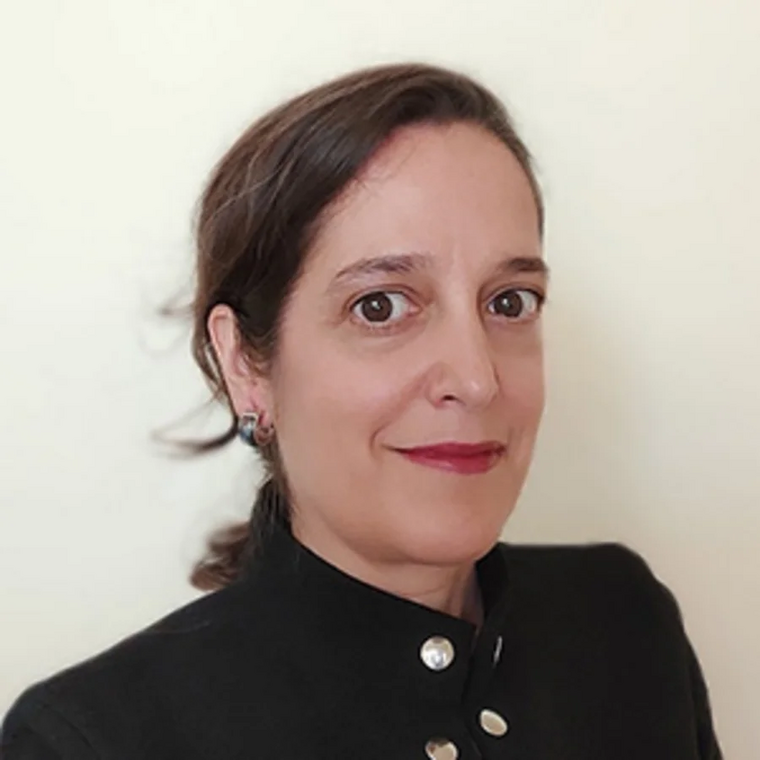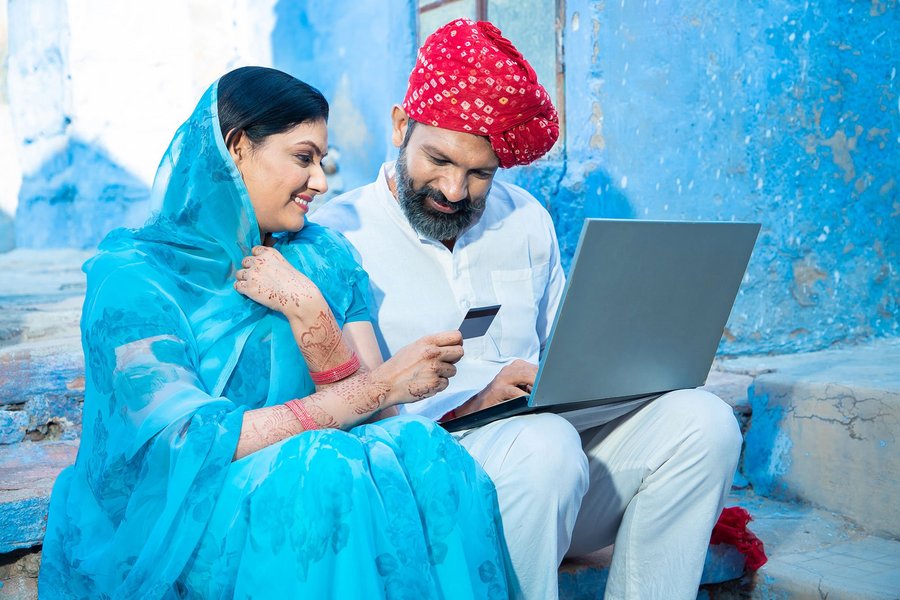Published: 07/03/2024

Innovating across borders and boundaries: a day at work in R&D in India
What does a day at work look like for an India-based head of R&D at G+D? How does one innovate successfully across borders and teams? Be flexible, have an appetite for risk, and do a lot of research, says Pune-based Lucie Fonseca, Senior Director R&D Card Issuance Services, G+D. Being good with languages helps as well.
From India, you run a global research and development setup for G+D. Tell us something about what you do?
I actually have two roles: a global R&D role, and a local R&D role for India. Card issuance services is a global role. That is one of the three verticals of R&D in the payment business, namely, card issuance services, digital solutions, and card products.
I’m in charge of card issuance services globally, which means I have a team here in India, Spain, Germany, the UK, and in Canada. It’s global – really, truly global. I have counterparts who take care of the other verticals who are based in Germany; they also have global teams.
I’m also in charge of the R&D center for our payment division in India as a whole, on a local level. So, it’s both local and global.

How does that work in detail?
The R&D team works on many different topics. Roughly half of my team works on what we call production software. This is software that runs inside the factories, controlling and organizing the production of payment cards. A payment card is a complex product with a lot of personal data. It takes some heavy software to produce that.
These are products that no one will ever see – but everyone can see the end result, which is the card itself. The material, its chip, the Visa or Mastercard payment application in it, and of course your personal information which makes it your card. When you put it together, you’re able to pay with it.
The other part is services that we build on top. For example, instant issuance. This is something that looks like an ATM, but is actually called a kiosk. You go to it and identify yourself, you authenticate yourself with information that your bank has provided, and you can get a personalized card issued on the spot. This allows banks in regions where there is little coverage to issue cards to end users, without them having to travel for hours to find a branch.
Our portfolio of Convego® Connect services comes to mind as well. These are various interfaces or APIs that we offer to banks, so they can have more control about what’s going on while we produce their cards. Among other things a bank might want to know:
When am I getting my cards? What’s the current status of this delivery? Can I pull one out of the batch because that particular person changed their address? I need an emergency replacement!
Innovation would be a big part of what an R&D unit does. How specifically do you promote and reward innovation?
We started a new concept around innovation this year in India. We call it Ideation Day. We take a number of participants from R&D, and we ask them to come up with ideas of possible innovations, preferably related to our business.
The ideas are based on the products they’re working on, but also what we see in the press, what they hear from other product lines. The idea is to ensure people step out of their day-to-day zones. One way to do this was to put them together in teams with people from different product lines, so exchanges happen spontaneously.
We had several presentations leading up to the event by people from the market and from the product lines. We also heard from our patent board, talking about innovation, what they’re hearing in the market, what customers are talking about, and what their pain points are. It was more focused on value for the customer, rather than just technical aspects. This broadens the perspective of the R&D team. They think more “business” and less “technical.” They come up with ideas, then they work in groups to refine and polish them so they can be considered seriously by our patent board, for example.
We also have a jury where we have the leaders of R&D – I’m part of it – but also people from the product team and others from customer-facing roles. The ideas are presented, and then we rate them in terms of innovative value, technology, potential for business. Then we give an award!
Who asks you to work on a particular project, or solve a specific issue?
My team mostly gets instructions from the product team. The product team might want a new service that will allow sending the PIN to customers in their mobile banking applications, rather than receiving an envelope in the mail with the PIN hidden behind a little sticker.
It’s better for the environment, we go paperless, there’s no logistics: all of that. And also because it’s safer – your PIN comes to your mobile application rather than in the post, where anybody can take it.
It could be the product team tells us the PIN should go by SMS, or mobile banking; it should be encrypted because the specific country where this is being deployed requires it, and so on. And then, my team writes the code to create this service.
We’ll write it, we’ll test it. We’ll go all the way to deploying it in a test environment, and then we’ll work hand in hand with the operations team to deploy this in the actual final environment, where the banks and their customers will be able to consume this service.
Your colleagues in the global R&D setup are all over the world. You’re in India, running a team that stretches to Canada. How do you structure your working day?
Well, the Canadians are in Toronto. It could have been worse in regards to time zones. They could have been in Vancouver [laughs]! I completely shifted my working hours. In winter, typically, I don’t start my day till noon in India. In summer, I might start at 11.
In general, people have been quite flexible. Many people in my Indian team work with Canada just like I do, so they have switched to the evening. In my experience, Indians do the same when they have to work with Australia. They shift to working earlier in the morning. It’s a very Indian thing to do. It’s something I appreciate about the country here. People are not really stuck on their timing.
How does your professional experience set you up to run an operation like this, that pulls together people from around the world, from different functions?
I’ve had jobs in development at the beginning of my career, where I was the one coding. I’ve worked in products, which is close to development, but with more focus on the road map, value proposition to the customers, and so on. I’ve worked in sales, and I’ve worked in delivery.
These are four functions that overlap at times, but have their own nuances. When I deal with account managers, well, I’ve been a salesperson. And vice versa: I also know how hard it is sometimes for R&D to be as responsive as the business would expect because of other constraints around budget, allocation, things like that. I can see both sides. I can usually understand what’s going on in the heads of the people I work with.
“My job is to talk to people and create bridges. Solve issues when they happen, perhaps due to a cultural misunderstanding. Sometimes it’s connecting the dots. It’s realizing that the questions that my Canadian team is asking – the guys in Spain are working on something similar!“
Senior Director R&D Card Issuance Services, G+D
How do you manage to keep working at an optimal level? Do you have advice for others who want to be leaders, in terms of time management and what to focus on?
Right now, most of my day is spent talking to people; coordinating, coaching, strategizing, and of course networking. I don’t develop software myself, for instance. There are a lot of very good specialists in my team who all know their stuff better than I do. There is no way I’m interfering there.
But I need to talk to my teammates who are based in all these different countries. I need to talk to some of the stakeholders, like our counterparts in product, for example, on a very regular basis. I have set regular meetings – weekly meetings, in fact – with most of them. So we talk, we have a catch-up.
The same goes for the local team. I have to talk to various departments regularly. When I’m not on the phone, that’s what I do.
My job is to talk to people and create bridges. Solve issues when they happen, perhaps due to a cultural misunderstanding, or different outlooks. Sometimes it’s connecting the dots. It’s realizing that the questions that my Canadian team is asking – the guys in Spain are working on something similar!
Tell us about your own background and life experiences. How does a French engineer end up running an R&D unit for a global entity like G+D in India?
Well, as you said, I’m French. I spent most of my life outside of France; as a kid first, but my working life as well. I left France about 20 years ago to start working abroad. In the end, I never came back.

It’s not like I had a grand plan to spend 20 years abroad, or to end up as an R&D head for G+D. But opportunities presented themselves. And I’ve always been pretty flexible. I studied to be an engineer. I am a telecommunications engineer. I love math, I love physics, I always liked technology – that’s not changed that much. I like to move to new countries. I like to try new jobs. I worked in France at the very beginning. I’ve worked in Russia, I’ve worked in Dubai. Now I work in India.
I worked mostly in the telecommunication and the payment domain. It looks like it was very much planned, but it wasn’t. It just happened. One interesting topic led to another one, and that’s how I started in telecom, then mobile payment, and finally payment. Job-wise, as I’ve mentioned, I’ve had many different functions from what I do now.
That’s what they call serendipity! What personal qualities do you think prepared you for all the places you’ve moved to professionally?
I would say having an open mind. Being willing to take a risk, and then getting as much information as possible about the country, about the business, about the job. That comes down to leveraging my network. I’ve always believed it’s a good idea to have a good network. You get to know a lot more about what’s going on.
You enjoy learning new languages. Tell us about that?
It is a hobby. Nowadays, I’m polishing my German, but I also know quite a bit of Hindi. And I like spending time doing this; to spend 15–20 minutes today studying German, or listening to podcasts to learn to improve my Hindi.
And English! We are having this conversation in English.
It’s a big driver in having an international career, the opportunity to use those languages. I moved to Russia purely to practice Russian. It’s good that I had an opportunity within my company for an interesting job, but the priority was to speak Russian.
This is one of the pleasures of living abroad: the exposure to many different languages, many different cultures, the opportunity to speak to people in their native tongue. It’s nice to be able to speak a bit of Hindi and talk to people here.
Build bridges? It seems like a theme.
There’s always a need for bridges. Professionally as well. Most of my career, I’ve been in the position where I am working in one country, and I’m not from that country. And my team is also working with other countries.
The last 20 years, I’ve been in jobs where you have to explain to a senior executive sitting in the US or in Europe how people work in India, for example. How is it different? How do people work in Russia, how is it different from business in the Middle East. Those bridges are absolutely required for all these cultural nuances.
You’re a female engineer, living and working in India. You’re a female leader in a tech company, which is traditionally seen as being a male domain. Is there a bias? Do you think young girls and women need to be encouraged to pursue a life in STEM (science, technology, engineering, and mathematics)?
So, India is doing well. I think we have about 30% of female students in STEM in India, which is really good. But I would say yes, generally, the stereotypes around engineering and mathematics still do a lot of harm to young girls who might have pursued STEM and don’t, because they are told girls don’t do mathematics.
But that’s the message that is passed by the media. If you look at movies, who are the scientists? Always men. Representation matters a lot. During COVID, when they were interviewing doctors, specialists, ministers, it was usually men. There are many female doctors. Where are they shown in the media? It’s a problem of representation that is worldwide. We have it in India, we have it in France, we have it in Germany.
It’s still an issue. Women need to be encouraged to picture themselves in this world, right? If you’re not given that kind of role model when you’re young, you might think unconsciously that this is not for you.
Another concern is that there are still a lot of companies around the world that are pretty hostile to women in the technology field. You are a minority and that is never fun, regardless of the minority you are.
As a leader, what would you do if you encountered bias of any sort, whether conscious or otherwise?
I’m very much on the side of educating people. Supporting people to build, and then walk across, bridges.
Share this article
Subscribe to our newsletter
Don’t miss out on the latest articles in G+D SPOTLIGHT: by subscribing to our newsletter, you’ll be kept up to date on latest trends, ideas, and technical innovations – straight to your inbox every month.


